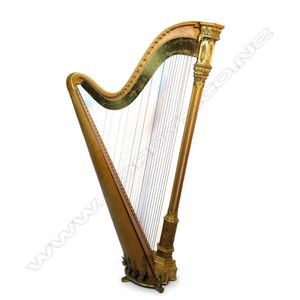Gothic 'Angel' Harp by Erard with 46 Strings
A mid 19th century gilt wood forty-six string Gothic 'Angel' harp by Erard, the top of the decorative hexagonal gilt column carved with angels playing instruments, leading down to an eight-pedal shaped base, featuring two gargoyles, maker's name Sebastian and Pierre Erard and company's London premises 18 great Marlborough Street, London at the top of harp, painted and gilded finish, requires attention. Together with a bespoke sturdy wooden crate with iron hinges and handles that was used to transport the harp in 1905 from England to New Zealand for the vendor's grandmother. 92 x 174 cm (harp)
You must be a subscriber, and be logged in to view price and dealer details.
Subscribe Now to view actual auction price for this item
When you subscribe, you have the option of setting the currency in which to display prices to $Au, $US, $NZ or Stg.
This item has been sold, and the description, image and price are for reference purposes only.
- Giltwood - Giltwood is used to describe a gold finish on furniture and other decorative wooden items, whereby a thin sheet of gold metal, called gold leaf, is applied to the surface for decorative purposes.
Unlike gilding, where the gold leaf is applied over a coating of gesso, with giltwood the gold leaf is applied direct to the surface, or over a coat of linseed oil gold leaf adhesive.
Most gold-finished mirrors will be gilded, whereas furniture with gold highlights will have the gold applied through the giltwood method. - Gilding - Gilding is a method of ornamentation whereby a thin sheet of gold metal is applied to items made of wood, leather, ceramics, glass and silver for decorative purposes.
For furniture including mirrors, the sheet of gold is usually applied over a coating of gesso. Gesso is a mixture of plaster of Paris and gypsum mixed with water and then applied to the carved wooden frames of mirrors and picture frames as a base for applying the gold leaf. After numerous coats of gesso have been applied, allowed to dry and then sanded a coat of "bole", a usually red coloured mixture of clay and glue is brushed on and allowed to dry, after which the gold leaf is applied. Over time parts of the gilding will rub off so the base colour can be seen. In water gilding, this was generally a blue colour, while in oil gilding, the under layer was often yellow. In Victorian times, gilders frequently used red as a pigment beneath the gold leaf.
Metal was often gilded by a process known as fire gilding. Gold mixed with mercury was applied and heated, causing the mercury to evaporate, the long-term effect of which was to kill or disable the craftsman or woman from mercury poisoning. The pursuit of beauty has claimed many victims, not the least of which were the artists who made those pieces so highly sought after today. - Erard - The distinguished Parisian firm Erard?s, makers of harps and pianos, were in business between 1777 and 1960.
The business was founded by Sebastien Erard, who had been apprentice to a Parisian harpsichord maker for two years before establishing his own workshop in the rue de Bourbon. In 1786 the company expanded by opening a branch in London, and in 1789 his brother Jean-Baptiste joined as partner.
Sebastien Erard obtained a number of patent registrations in both England and France, for design innovations to both the harp and piano, the most important being for the double-action harp in 1810, the forerunner to today's concert harp.
This item has been included into following indexes:
